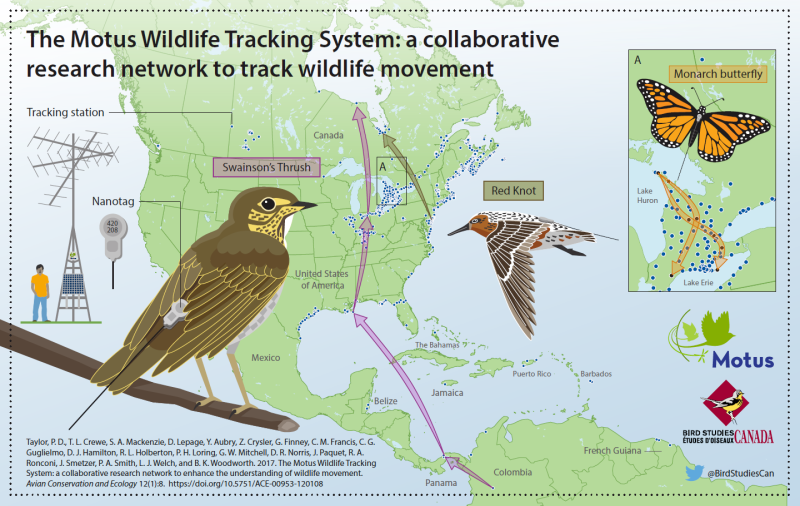HOME | satellite telemetry | acoustic telemetry | geolocators | radio telemetry | motus wildlife tracking system
individual marking | molecular markers | stable isotopes | movement models | future methods
Overview
Recently developed radio transmitter and receiver technology now allow for automated tracking of animals at local, regional, and continental scales.
Automated radio tracking systems are custom built in a variety of styles depending on their use, but essentially consist of: 1) an automated radio receiver, 2) one to four antennas, 3) the tower structure, and 4) a power source. A variety of antenna types (see Radio Telemetry for more information) can be used depending on the desired use. Automated radio systems can be affixed to existing structures (tall buildings, cell phone towers, etc.) or to stand-alone towers built by the user. Automated radio systems may be connected to an existing power source or may be solar powered for more remote locations. Detection data can be downloaded directly from the receiver unit. Alternatively, towers can be connected to wired or wireless internet, or communicate through cell phone technology, which allows for around the clock remote access to detection data.
For a detailed overview of Motus, see Taylor et al. (2017) or visit the Motus website.
How does it work?
Automated radio tracking systems take advantage of new coded transmitter technology. Unlike traditional radio transmitters which each emit a signal at a unique frequency, coded transmitters all emit a signal at the same frequency, but are uniquely identifiable. This allows the automated radio receiver to listen for hundreds of transmitters at the same time, vastly increasing the likelihood of detection, compared to traditional systems, which would have to cycle through each individual radio frequency.
Automated radio towers can be arranged to track birds at local, regional, and continental scales. Dense arrays of radio towers can be used to track local movements and if animals are detected by multiple towers, triangulation (see above) can be used to provide precise movement data. Coordinated arrays of automated radio towers, such as those organized by Bird Studies Canada’s Motus Wildlife Tracking System, allow for tracking of animals at continental scales. Motus currently consists of over 900 receiving stations located throughout the world, with additional towers coming online each year. Animals passing within range of these towers are automatically detected, detection data is then logged on the receiver and passed on to the researchers that tagged that animal. Tagged animals can be detected by automated radio towers from as far away as 15 km, but detection range depends on many factors, including tower height, antenna type and orientation, terrain, vegetation, and height of the animal relative to the tower.

Infographic of Motus automatic radio telemetry system. For more information, see Taylor et al. (2017).
Edited by Nathan Cooper (Smithsonian Migratory Bird Center), 2016.
Updated by Allison Huysman (Migratory Connectivity Project, huysmana@si.edu), 2020.
References
- Taylor, P. D., T. L. Crewe, S. A. Mackenzie, D. Lepage, Y. Aubry, Z. Crysler, G. Finney, C. M. Francis, C. G. Guglielmo, D. J. Hamilton, R. L. Holberton, P. H. Loring, G. W. Mitchell, D. Norris, J. Paquet, R. A. Ronconi, J. Smetzer, P. A. Smith, L. J. Welch, and B. K. Woodworth. 2017. The Motus Wildlife Tracking System: a collaborative research network to enhance the understanding of wildlife movement. Avian Conservation and Ecology 12(1):8.
HOME | satellite telemetry | acoustic telemetry | geolocators | radio telemetry | motus wildlife tracking system
individual marking | molecular markers | stable isotopes | movement models | future methods

